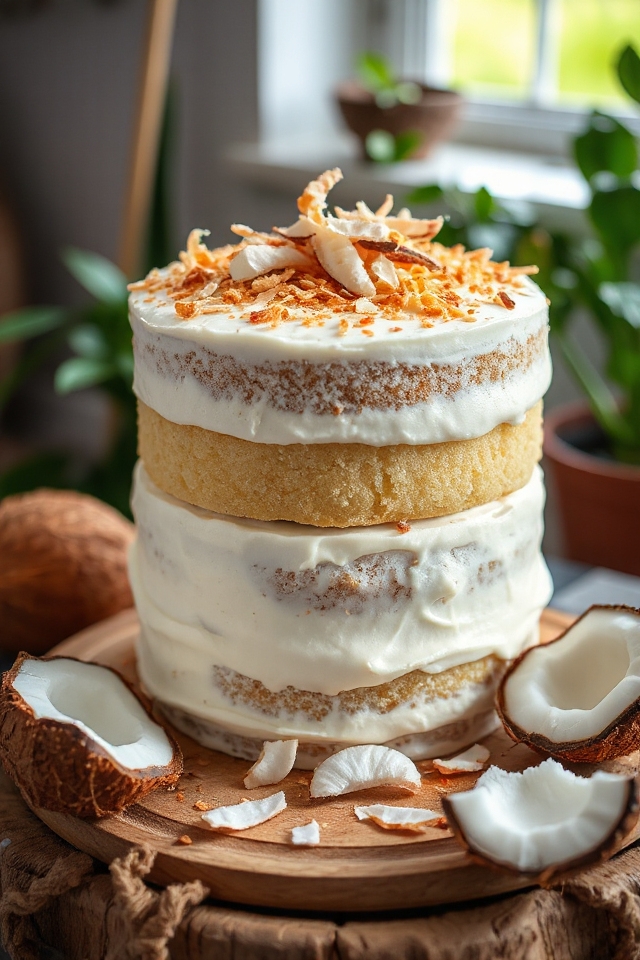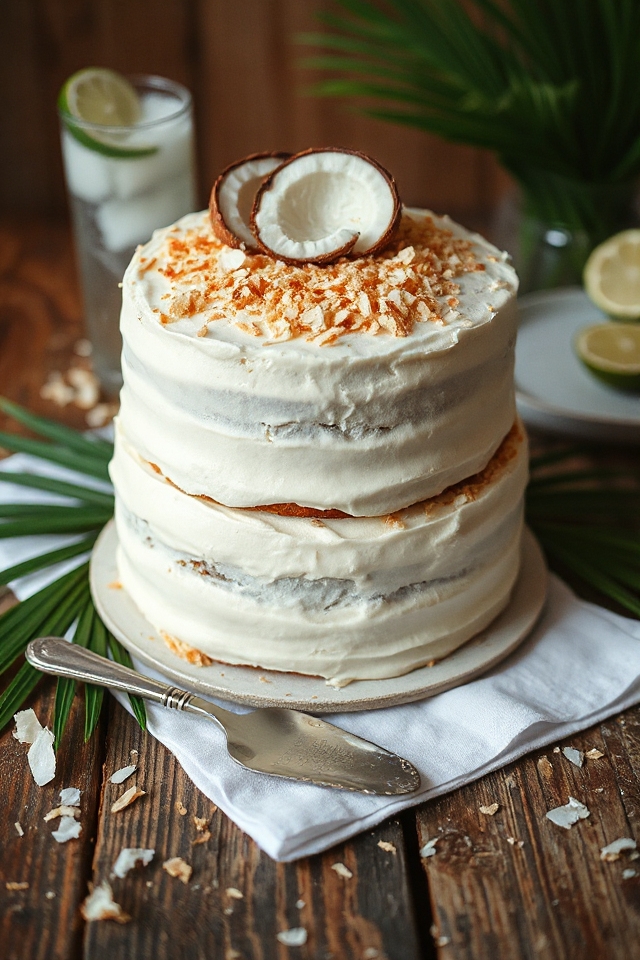Why You’ll Love This Coconut Cake Recipe
If you’re searching for a dessert that’s both delicious and crowd-pleasing, you’ll love this coconut cake recipe. It’s moist, fluffy, and packed with coconut flavor, making it a standout at any gathering.
I’ve served this cake at birthdays, holidays, and casual get-togethers, and it never fails to impress. The combination of sweet coconut and buttery goodness creates a delightful experience with each bite.
Plus, it’s simple to make, so you won’t stress in the kitchen. Trust me, once you try this coconut cake, you’ll find it hard to resist going back for seconds—or even thirds!
Ingredients of Coconut Cake
When it comes to baking a coconut cake, having the right ingredients is essential. You want to make sure your cake turns out moist and flavorful, and trust me, nothing is worse than a dry cake.
So, let’s gather what you need. Here’s a straightforward list that will have you on your way to coconut cake bliss in no time.
Ingredients for Coconut Cake:
- 3 cups sugar
- 3/4 cup shortening
- 4 eggs
- 3/4 cup shredded coconut
- 4 1/2 cups flour
- 4 1/2 teaspoons baking powder
- 3/4 teaspoon salt
- 1 1/2 cups milk
- 1 1/2 teaspoons vanilla extract
Now that we’ve got our ingredients lined up, let’s chat about them a bit.
First off, using fresh or good-quality shredded coconut can really elevate your cake. I once made it with that bagged stuff, and let’s just say, the texture was… less than ideal.
And don’t skimp on the sugar—it’s what gives that delightful sweetness that everyone loves.
Also, the shortening helps keep the cake moist, but if you’re feeling adventurous, you can swap it for butter for a richer flavor. Just a heads up, though, it might alter the texture a smidge.
How to Make Coconut Cake

Alright, let’s explore the delicious world of coconut cake making. First things first, you’ll want to grab your mixing bowl and get ready to cream together 3 cups of sugar and 3/4 cup of shortening. This step is essential because it’s where the magic begins. You want to mix it until it’s fluffy—think clouds, not bricks.
Once you’ve achieved that light and airy texture, it’s time to introduce the stars of our show: the eggs. You’ll add 4 eggs, one at a time, mixing well after each addition. This is where you can feel like a real baker, whisking away and imagining your cake rising in the oven.
Now, let’s fold in 3/4 cup of shredded coconut. This is the point where your kitchen will start smelling like a tropical paradise. After that, you’ll want to sift together your dry ingredients: 4 1/2 cups of flour, 4 1/2 teaspoons of baking powder, and 3/4 teaspoon of salt. Yes, I know sifting can be a bit of a hassle, but trust me, it makes for a lighter cake.
Now, here comes the fun part—alternate adding the dry mixture with 1 1/2 cups of milk and 1 1/2 teaspoons of vanilla extract to your sugar/shortening/egg mixture. Start and end with the dry ingredients. It’s like a baking dance, and you want to keep it smooth and steady.
Once everything is mixed together and looking beautiful, it’s time to divide the batter evenly into two greased and lightly floured 9-inch cake pans. I always take a moment to appreciate how lovely the batter looks, but remember, it’s all about what it’ll be when it’s baked.
Pop those pans into a preheated oven at 350 degrees and let them bake for about 30 to 35 minutes. You’ll know they’re ready when a toothpick inserted in the center comes out clean. Just imagine the smell wafting through your kitchen—can you smell the coconut yet?
Once done, let the cakes cool before you frost them, because no one likes a melted frosting disaster, right? Enjoy the process, and don’t forget to sneak a little taste of that batter because who can resist that?
Coconut Cake Substitutions & Variations
While coconut cake is delicious as is, there are plenty of substitutions and variations to explore that can elevate your baking experience.
For a lighter cake, try using Greek yogurt instead of shortening. If you want a tropical twist, add crushed pineapple or mango puree to the batter.
You can also swap out some of the flour for almond flour for a nutty flavor. If you prefer a dairy-free option, use almond or coconut milk.
For extra texture, throw in some chopped nuts or toasted coconut flakes. Each variation can bring a unique flair to your delightful coconut cake!
What to Serve with Coconut Cake
To enhance your coconut cake experience, consider pairing it with a light and invigorating fruit salad.
I love mixing fresh pineapple, mango, and kiwi for a tropical twist that complements the cake’s flavors perfectly. You can also serve it with a scoop of vanilla ice cream or a dollop of whipped cream for added richness.
If you’re feeling adventurous, a tangy citrus glaze can elevate the dessert even further.
For a beverage, a revitalizing iced tea or a fruity lemonade pairs wonderfully.
These accompaniments not only enhance the cake but also create a delightful, well-rounded dessert experience!
Additional Tips & Notes
When preparing your coconut cake, a few additional tips can make a significant difference in the final result. First, use fresh coconut for a richer flavor; it really enhances the cake’s texture.
I also recommend letting your eggs and milk come to room temperature before mixing, as this helps with the batter’s consistency. Don’t forget to check your cake a few minutes before the baking time is up; every oven varies.
Finally, allow the cake to cool completely before frosting to prevent the icing from melting. These small steps will elevate your coconut cake to a whole new level!
